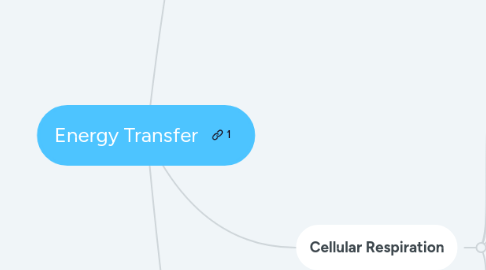
1. Photosynthesis
1.1. Light-Dependent Reactions
1.1.1. Uses sunlight to create energy rich-compounds such as ATP.
1.1.2. Occurs in the thylakoid membrane in the chloroplast
1.1.2.1. Thylakoids contain photosystems, which are essential to the light-dependent reactions.
1.1.2.2. The light dependent reactions begin when Photosystem 2 absorbs light
1.1.2.3. Electrons move down the electron transport chain and pump H+ ions from the stroma into the thylakoid space.
1.1.2.4. Electrons are then re-energized in Photosystem 1.
1.1.2.5. This creates a gradient that is used to make ATP. NADPH and oxygen are produced as well.
1.1.3. Water is required as a source of electrons and hydrogen ions
1.1.4. Oxygen is released as a byproduct
1.2. Light-Independent Reactions
1.2.1. High energy sugars from carbon dioxide are produced such as ATP and NADPH.
1.2.2. Require no light
1.2.3. Occurs in stroma, not thylakoids.
1.2.3.1. Carbon dioxide from the atmosphere produces 3-carbon compounds that continue into the cycle.
1.2.3.2. These molecules interact with nitrogen, sulfur, and phosphorous to create sugar.
1.2.3.3. As a result, 6 molecules of carbon dioxide are used to create a 6-carbon sugar.
1.2.3.4. As a result, stable, high-energy sugars are created from carbon dioxide and water.
1.2.4. Works with Light-Dependent Reactions to create carbohydrates.
2. Fermentation and Respiration
2.1. When there is no oxygen, the electron transport chain does not run, so there is nowhere for the NADH molecules to deposit their electrons.
2.2. Since there is no oxygen for glycolysis (which is anaerobic), a process known as fermentation comes in.
2.3. Fermentation releases energy from food molecules by producing ATP when there is no oxygen.
2.3.1. During fermentation, cells concert NADH into the electron carrier NAD+, allowing glycolysis to produce a steady supply of ATP. This occurs in the cytoplasm of cells.
2.3.1.1. In alcoholic fermentation, pyruvic acid and NADH are used to create alcohol, carbon dioxide, and NAD+.
2.3.1.2. Alcohol is produced this way and bread dough rises this way.
2.3.1.3. In Lactic Acid Fermentation, Pyruvic acid and NADH are used to create Lactic acid and NAD+.
2.3.1.4. Bacteria that is used to create cheese, yogurt, buttermilk, and sour cream undergo lactic acid fermentation. Pickles, sauerkraut, and kimchi are also produced using lactic acid fermentation.
2.3.1.5. Humans undergo lactic acid fermentation also. During brief periods without oxygen, cells in our bodies are capable of producing ATP by lactic acid fermentation. Muscle cells are best adapted to that and need very large supplies of ATP for rapid bursts of activity.
3. Cellular Respiration
3.1. Oxygen and glucose are used to produce carbon dioxide, water, and energy.
3.2. Glycolysis is first stage
3.2.1. Only a small amount of energy is captured to produce ATP during this stage. 90% of the chemical energy is still unused.
3.3. Krebs cycle is second stage
3.3.1. A little more energy is generated at this stage.
3.4. Electron transport chain is third stage.
3.4.1. Requires reactants from the other two stages of the process to create bulk of energy from cellular respiration.
3.5. Photosynthesis and cellular respiration are in balance.
3.5.1. Photosynthesis deposits energy, cellular respiration withdraws energy.
3.5.2. Their equations are actually opposite each other, believe it or not.
3.5.3. Photosynthesis removes carbon dioxide from the atmosphere, and cellular respiration puts it back.
3.5.4. Photosynthesis releases oxygen into the atmosphere, and cellular respiration uses that oxygen to release energy from food.
